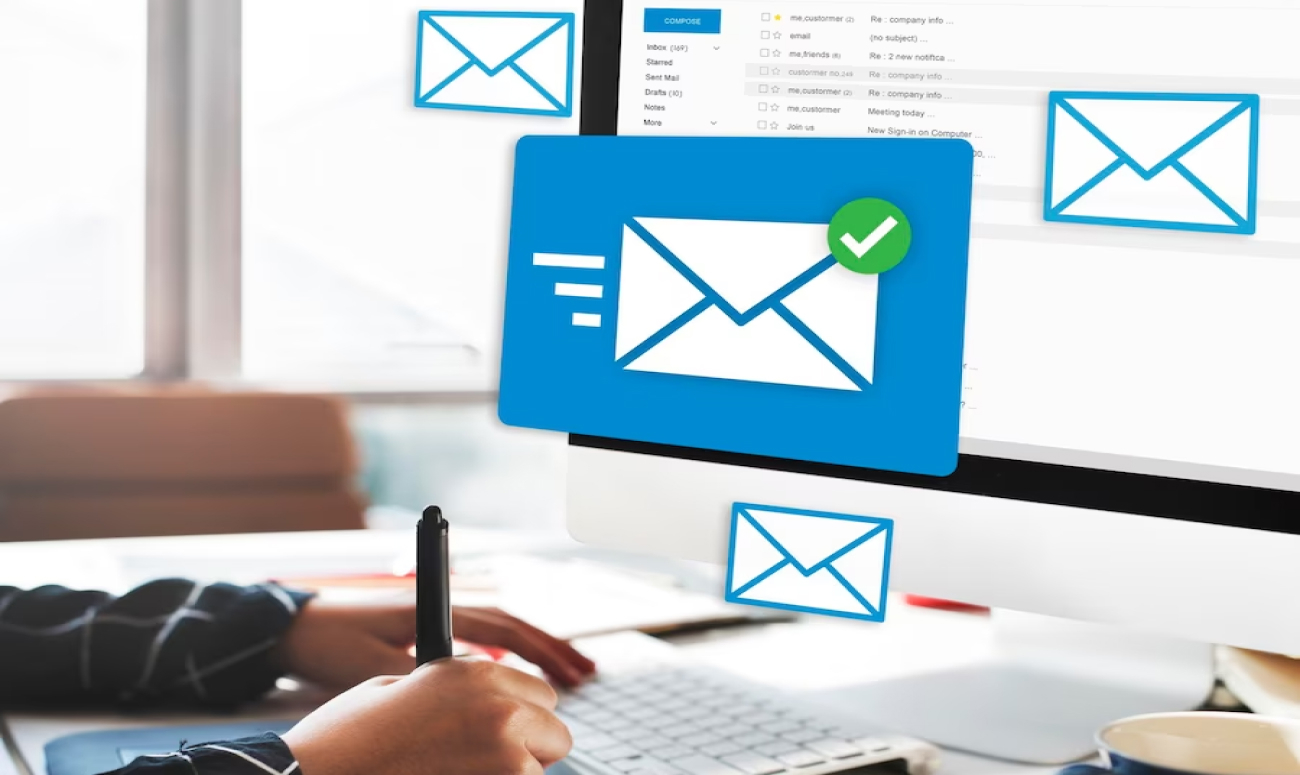
Email marketing campaigns allow you to quickly convey information about your brand and cultivate relationships with your target audience.
Creating brand awareness is crucial to stay ahead of the competition. Businesses need to find inventive ways to reach out and ensure their target customer base knows who you are, what services or products you offer, and why people should choose your company over another.
One way to do this is through effective email marketing campaigns that can help boost your business while staying within budget. However, creating an effective email campaign can take more work than it sounds.
Small businesses can benefit from email marketing campaigns to reach new customers and increase brand awareness. Using customer relationship management (CRM) software, small businesses can create targeted campaigns that reach existing and potential paying customers. Automated processes can also quickly access contact data to ensure enterprises send the right message at the right time.
Customer relationship management (CRM) and a marketing automation strategy work together to create an email marketing campaign. In this blog post, we’ll share ten tips on creating successful email marketing campaigns that will help you increase brand awareness and drive conversions for your business.
1. Set clear goals
Setting clear goals is paramount to increasing brand awareness when creating effective email marketing campaigns with marketing CRM software. First, determine what you want to achieve with your email marketing efforts. For example, do you want to increase brand awareness, drive sales, or promote a new product? Setting goals will help you measure the success of your campaign and make necessary adjustments.
These measures help the sales and marketing team understand what strategies must be employed and how best to automate processes for optimal customer engagement. Goals should include short-term objectives for immediate impact and long-term objectives for overall marketing ROI. Having specific, well-defined goals that businesses can track over time will help ensure success in any email marketing campaign through CRM software.
And with automated, marketing tools and processes, you can quickly reach out to customers. It also helps cultivate customer relationships, leading to customer loyalty while staying within budget. So take advantage of all the possibilities with marketing automation today!
2. Choose the right email marketing automation platform
When choosing the right email marketing automation platform, many are available, each with its features and pricing—research different marketing automation platforms to find one that best fits your needs and budget. There are many factors to consider. Identifying what is essential for your business, such as understanding which email marketing tools best suit your needs, is critical.
Companies should consider lead management features to ensure a successful outcome. Companies of all sizes can benefit from an effective email marketing platform, whether a small business or a large enterprise. They both can gain efficiencies and save time managing their marketing business processes. It also helps sales reps improve customer experience by providing complete customer satisfaction.
3. Start with a welcome email

A welcome email is a great way to introduce your brand to new subscribers and set expectations for what they can expect from your emails. It’s also an opportunity to build customer interactions and get them interested in your business and ready to take action.
Welcome emails also give opportunities for upselling and cross-sell products and introducing new services or offers. It’s an essential part of any email marketing efforts and should be used to help build relationships with customers, leading to enhanced customer retention.
Your welcome email should be concise and include information about your brand, what you offer, and how the reader can get started.
4. Build a quality email list
The first and most crucial step in creating a successful email marketing campaign is to build an accurate, up-to-date list of contacts. Building a quality email list is essential for any successful email marketing campaign as it allows companies to target and engage with qualified leads. Teams can do that through various contact management tools or CRM software that enables companies to keep track of customers and build relationships. These CRM and marketing automation work improve customer relationships.
An efficient way to do this is by leveraging existing customer data and adding new contacts that have expressed interest in your company or products. Avoid buying lists, as they could contain outdated or incorrect information.
You should also collect email addresses from interested parties and potential customers, and avoid purchasing email lists or scraping email addresses. You want to ensure that the people receiving your emails are genuinely interested in your brand and what you have to offer.
5. Personalize your emails
Personalization is the key to making your emails stand out in a sea of inbox clutter. Think beyond just including a recipient’s name in the subject line or body of an email; use personalization to tailor content to each individual. It will improve customer relationships.
Personalization is a powerful tool that allows you to customize emails and make them more relevant to customers. You can use personalization tactics such as segmentation, dynamic content, and A/B testing to ensure personalized campaigns for each recipient’s needs. This personalization will help customer retention, improve response rates, and drive conversions.
Personalized emails have higher open rates, click-through rates, and conversion rates. In addition, you can personalize your emails by including the recipient’s name, location, or previous purchase history.
6. Crafting Attention-Grabbing Email Subject Lines

In today’s world of overflowing inboxes, crafting attention-grabbing email subject lines has become more critical than ever. Whether you are seeking to create awareness for your brand, generate leads, or promote your products or services, the email subject line plays a vital role in the success of your email marketing campaign.
Why Your Email Subject Line Matters for Brand Awareness
One of the main reasons your email subject line matters for brand awareness is that it is often the first thing your customers see when they receive your email. According to recent research, over 47% of email recipients decide whether to open an email based on the subject line. Therefore, a catchy, exciting, and personalized email subject line could differentiate between your email being opened or sent to the trash folder.
The Anatomy of a Great Email Subject Line
The anatomy of a great email subject line involves three critical components: relevance, curiosity, and value. A relevant email subject line lets the recipient know why they should be interested in your email, while curiosity piques their interest, making them want to open it. Lastly, the value incentivizes them to open your email and take action.
Tips for Creating Personalized Subject Lines to Boost Brand Awareness
When creating personalized subject lines to boost brand awareness, the key is to tailor your subject line to your customer’s interests and needs. For instance, using their first name in the subject line can create a more personal connection with the recipient. Additionally, incorporating a question or emoji can increase the chances of your email getting opened.
The Dos and Don’ts of Writing Effective Email Subject Lines
There are several dos and don’ts when writing compelling email subject lines. Firstly, ensure your subject line aligns with your email’s content. That ensures your recipients should feel satisfied when they open your message. Secondly, be moderate with punctuation, capitalization, and special characters, as it can be unprofessional. Lastly, test your subject lines to see what works best for your audience.
7. Creating Engaging Email Content
Creating engaging email content is a crucial component of any successful marketing campaign. As email marketing automation continues to be a popular and effective way of reaching out to customers, crafting compelling email copy that resonates with your target audience is essential.

Tips for Creating Engaging Email Copy that Resonates with Your Audience
Here are a few tips to help you create email copy that engages your audience:
Personalize Your Emails
Personalization is critical to creating engaging email content. You can segment your email list based on demographics or interests and tailor your message accordingly. By doing so, you can catch the reader’s attention and ensure that they feel understood and valued.
Use a Conversational Tone
A conversational tone creates a connection between you and your audience. Keeping it simple and relatable is essential so the reader feels like you are talking directly to them. Using a conversational tone increases the reader’s engagement and encourages them to take action. As a result, it helps in better customer communications and leads to a seamless customer experience.
Highlight the Benefits
It’s critical to highlight the benefits of your product or service. Doing so will increase the reader’s interest in what you are offering. Focusing on the benefits shows readers how your product/service can solve their problems and improve their lives. It can help marketing teams reach all stages of the customer lifecycle, leading to business growth.
Focus on a Clear Call-to-Action (CTA)
The CTA is vital to any email campaign. A clear and concise CTA takes the reader to the next step in the conversion process. Whether purchasing, signing up for a course, or downloading a resource, a CTA should be compelling and eye-catching.
Apart from this, businesses should keep on analyzing the success rates of their emails in terms of social media marketing and try different options, like building landing pages to boost conversion rates.
Use Storytelling to Increase Brand Awareness in Your Emails
Storytelling is another effective way of creating engaging email content. You can make an emotional connection with the reader by telling a story. For example, you can highlight a customer’s challenges before discovering your product or service and show how your solution helped them overcome them.
The Power of Visuals in Email Marketing Automation for Improved Brand Awareness
Do you rem ember a picture or video or content you read? Undoubtedly, visuals (image and video). That is because visuals tend to be more powerful than the written word. That’s why incorporating visuals into your email campaigns can significantly impact engagement and brand awareness. Utilizing visual assets such as infographics, videos, GIFs, or product images can help make your emails stand out from the crowd.
Visuals can create a lasting impression on the reader and make your message stand out. Visuals also increase the reader’s engagement and make your brand more memorable.
8. Designing Effective Email Templates

Email Marketing Automation has been a popular means of communication between businesses and their customers or subscribers. However, with the increasing competition in the digital space, it has become essential to design effective email templates to cut through the clutter and grab the reader’s attention. Therefore, this task focuses on providing a comprehensive guide to creating effective email templates.
The Elements of an Effective Email Template
An effective email template comprises various elements that enable it to achieve its aim of promoting or sharing information with the reader. As already discussed above – One of the essential elements of an effective email template is a catchy subject line that can pique the reader’s interest and encourage them to open the email. Additionally, the email should have a clear and concise message that is easy to understand and digest.
Another critical element of an effective email template is the design. The email design should be visually appealing and aligned with the brand’s identity. It must also be optimized for mobile devices, as most people access their emails on their smartphones.
How to Use Color Psychology to Increase Brand Awareness in Your Emails
Using the right colors in an email can significantly impact the reader’s perception of the brand. Color psychology is the study that explains how color affects human behaviors and emotions. By leveraging color psychology, brands can use specific colors to evoke emotions and increase brand recognition.
For instance, using red in an email can evoke a sense of urgency or excitement, while green can promote a feeling of calmness and relaxation.
The Dos and Don’ts of Email Design for Maximum Brand Impact
When designing an email template, businesses must consider dos and don’ts to ensure maximum brand impact.
For instance, businesses should aim to keep the email content short and scannable to avoid overwhelming the reader. On the other hand, too many images or graphics can make an email look cluttered and distract from the message.
Do use a professional email address.
Your email address is one of the first things potential customers will see, so you want to ensure that it is professional and reflects your brand positively. Avoid using personal email addresses (such as Gmail or Yahoo) for your business. Instead, create a custom email address that uses your company name.
Do use a consistent layout and design.
Your emails should have a consistent layout and design that aligns with your overall branding. This layout will make your emails instantly recognizable and help to build trust with potential customers. Use the same colors, fonts, and logos in your email designs as you do on your website and other marketing materials.
Do keep your emails short and to the point.
People are busy, and their inboxes are full, so you want to ensure your emails can be easily read and understood. So keep your emails short, using clear language and bullet points when possible. And always include a call-to-action (CTA), so recipients know what you want them to do next.
Use only a little text.
In addition to keeping your emails short, you also want to avoid using too much text. Instead, use images, infographics, and videos to break up the text and make your emails more visually appealing.
Remember mobile users.
With more people than ever reading emails on their smartphones, it’s important to design your emails with mobile users in mind. Keep your designs simple and easy to read on small screens, and use large fonts and buttons for CTAs so that consumers can easily click them on mobile devices.
Pay attention to your subject line.
Your subject line is one of the essential elements of your email, as it will determine whether or not people open your email in the first place.
9. Targeting and Segmentation Strategies

One critical factor that makes email marketing such an effective tool for brand promotion is the ability of email marketing to target a specific audience based on segmentation. Targeting and segmentation strategies allow for greater customization and personalization of your email campaigns, leading to higher engagement rates and increased brand awareness.
Why Targeted Emails are More Effective for Brand Awareness
Targeted emails are more effective as they are tailored to specific groups of people based on their needs, likings, behaviors, and demographics. That allows for more relevant content and messaging that resonates with the recipient and makes them take action. Targeted emails also help to avoid the pitfall of generic or irrelevant content that can turn off potential and prospective customers and hurt your brand reputation.
Many CRM tools with a marketing automation solution available today track a customer journey through customer lifecycle stages and segment them, which helps marketing teams build targeted emails.
How to Use CRM Data to Segment Your Email List for Maximum Impact
To segment your email list effectively, it is important to use customer relationship management (CRM) data to understand your audience’s preferences and needs. For example, businesses can analyze customer behavior, demographics(Age, gender, location), psychographics(values and beliefs), purchase history, contact information, and engagement with previous email campaigns.
Once you have segmented your customers into smaller groups, you can create and send more personalized emails that are tailored directly to their interests and needs. This personalization will improve your chances of making a successful campaign and increase customer loyalty and brand recognition.
This results in higher open rates, click-through rates, and, a higher ROI for your email campaigns.
The Benefits of Creating Different Email Campaigns for Different Segments of Your Audience.
Creating different email campaigns for different segments also has many benefits. First, it allows for greater customization and tailoring of your messaging to ensure it resonates with each group. This customization can increase the effectiveness of your campaigns and improve engagement rates. Additionally, creating different campaigns for different segments can help to build loyalty and trust with each group, as they feel that their needs and interests are being heard and catered to.
The various benefits of targeted email campaigns for different segments are:
Increased Engagement
More Targeted Messaging
Greater Insight into Customer Needs
Improved Deliverability
Reduced Costs
10. Measuring Email Marketing Success

Measuring the success of an email marketing campaign can sometimes be challenging. Fortunately, specific metrics measure the success of an email marketing campaign, which can help businesses optimize their strategies and achieve better results.
The Most Important Email Marketing Metrics to Measure
There are various metrics to measure the success of your email marketing campaigns. Below are essential metrics you can measure:
Open Rate
Open Rate measures the percentage of subscribers who opened an email. A high open rate indicates that subscribers found the email enticing and relevant to their interests.
Click-Through Rate
Click-Through Rate measures the percentage of subscribers who clicked on a link within the email, indicating that they found the content engaging and valuable.
Conversion Rate
The conversion rate is the number of people who take a desired action (such as purchasing a product or service) out of the total number of people who receive an email. The conversion rate is an excellent metric to measure the success of your email marketing campaign’s success, as it will indicate how effective your emails are at driving sales or leads.
Unsubscribe Rate
The unsubscribe rate is the percentage of people who unsubscribe from your email list out of the total number of people who receive your emails. It will give you an indication of how many people are no longer interested in receiving your emails.
How to Use CRM Analytics to Improve Your Email Marketing Strategy
Enterprises use CRM analytics to improve email marketing strategies. By analyzing customer data (preferences and purchase history), businesses can tailor their emails to individual subscribers. This data makes the content more relevant and increases the chances of conversion. In addition, A/B testing can be a highly effective way to optimize email campaigns. By testing different versions of an email on a sample of subscribers, businesses can determine the most effective elements of an email and use these to create a more successful campaign.
How to Set Realistic Goals and Evaluate the Success of Your Email Marketing Campaigns

It is crucial to define clear and measurable objectives based on data-driven insights. By constantly monitoring and analyzing key metrics, businesses can adapt their strategies and achieve their goals. In short, measuring email marketing success requires strategic planning, data analysis, and continuous optimization. As a result, email marketing can be a highly effective tool for driving sales and developing long-term customer relationships.
For More Information on effective email marketing best practices, click here.
Wrapping Up
Email marketing is a powerful tool to reach new audiences and increase sales. When done correctly, email marketing can help to build and manage customer relationships and drive profitability. Businesses can ensure their email campaigns are successful by creating different campaigns for different audience segments, leveraging CRM analytics, setting realistic goals, and measuring key metrics.
Many products are available when it comes to finding the best CRM software for effective email campaigns. EQUP is one of the leading CRM solutions businesses can use to optimize email marketing strategies. It provides various tools like segmentation, automation, and A/B testing. Sign up now!